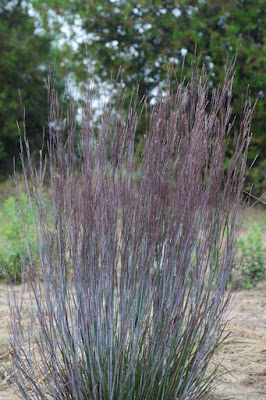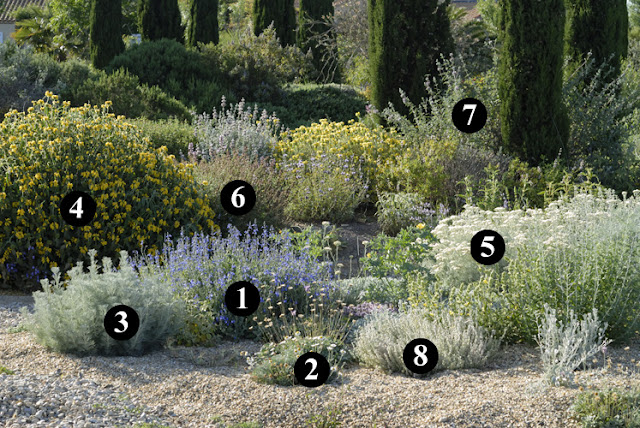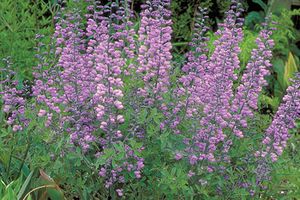LITTLE BLUESTEM = a native grass you will love
'Blue Paradise' Little Bluestem courtesy of Proven Winners Deep wine purple fall color.
When the American Horticultural Society decided to create a large meadow at their headquarters, River Farm, in Virginia the first plant they seeded was Little Bluestem. ( I wrote about this earlier but have added to it. )
Photo Courtesy of Lazy S'S Farm
They applied 100 pounds of Bluestem seed. The Latin name is Schizachyrium scoparium or skiz-ah-KEER-ee-um sko-PAR-ee-um.
Why was this the first plant they seeded? Because Little Bluestem is a NATIVE, wonderful, durable, upright, clump forming grass that is eminently suitable for 'meadow making'.
'The Blues' courtesy of the Battery Database
Little Bluestem is native to almost all of the United States and parts of Canada. It is found in 45 of the 50 states, making it the most abundant of all native grasses.
It is drought and flood-tolerant, can grow in light shade and thrives in relatively poor, sharply drained soil. It is found in woodland glades and both upland and lowland prairies.
The most thrilling aspect to me about this plant is the unusual depth of its dense, fine and fibrous roots.
This is a photo of switchgrass roots but it is similar to bluestem roots.
Little Bluestem's roots grow almost vertically downward to depths comparable to shade trees!
This is why it is drought tolerant, why it needs no fertilization and why it is often used for erosion control on slopes.
This is a photo of switchgrass roots but it is similar to bluestem roots.
switchgrass roots
Little Bluestem's roots grow almost vertically downward to depths comparable to shade trees!
This is why it is drought tolerant, why it needs no fertilization and why it is often used for erosion control on slopes.
Little Bluestem is extremely cold hardy, deer resistant and is an excellent grass for the garden. In summer, striking silvery blue stems form a columnar habit. Little Bluestem is the state grass of Nebraska
It's slender blue-green foliage grows from 18 inches to 3 feet tall. Its stems are purplish at the base and the foliage turns a striking russet red in the fall. The soft wispy silvery seed heads bloom in late summer through early fall and are ornamental through winter, making it perfect for the native winter landscape.
It is also a fabulous plant for wildlife, being a larval host plant for the Dusted, Arogos, Meske's, Peck's, Cobweb and Crossline Skipper Butterflies.
Its fine clumping foliage provides protective cover and nest sites for many birds and its seed heads supply them with food.
It is one of the plants in the National Wildlife Federation's BIRD GARDEN (click here) landscape plan.
courtesy of Native Plant Associates
It's slender blue-green foliage grows from 18 inches to 3 feet tall. Its stems are purplish at the base and the foliage turns a striking russet red in the fall. The soft wispy silvery seed heads bloom in late summer through early fall and are ornamental through winter, making it perfect for the native winter landscape.
Arogos Skipper Butterfly (birdsofoklahoma.net)
It is also a fabulous plant for wildlife, being a larval host plant for the Dusted, Arogos, Meske's, Peck's, Cobweb and Crossline Skipper Butterflies.
Its fine clumping foliage provides protective cover and nest sites for many birds and its seed heads supply them with food.
courtesy of Intentional Living Blog
It is one of the plants in the National Wildlife Federation's BIRD GARDEN (click here) landscape plan.
'The Blues'
'The Blues' variety is a spectacular Blue form of Little Bluestem.
It thrives in heat and humidity and looks excellent in massed plantings, as a groundcover or mixed with other native grasses and perennials. It adds a fine, delicate texture to plantings. The Blues Bluestem will grow to be about 24 inches tall at maturity extending to 32 inches tall with the flowers, with a spread of 18 inches. It grows at a medium rate, and can be expected to live for approximately 10 years.
It thrives in heat and humidity and looks excellent in massed plantings, as a groundcover or mixed with other native grasses and perennials. It adds a fine, delicate texture to plantings. The Blues Bluestem will grow to be about 24 inches tall at maturity extending to 32 inches tall with the flowers, with a spread of 18 inches. It grows at a medium rate, and can be expected to live for approximately 10 years.
Here is a small Songbird garden developed by Johnson's Gardens. It contains Dwarf Pavement Shrub Rose, The Blues Little Bluestem Grass, October Skies Aster, Kobold Blazing Star, Magnus Purple Coneflower, Viette's Little Suzy Rudbeckia, Zagreb Coreopsis, Prairie Dropseed Grass
You can use Little Bluestem as a lawn replacement. It is common in many low maintenance seed mixtures combined with other lower growing natives. You can spread these seeds in open recreational areas, along roadsides and in wildlife habitats. But do not despair the first year after seeding - these deep rooted grasses grow down, not up, during the establishment year. This means that the top growth may be nothing more than a narrow, straight leaf until late in the summer. It can be hard to see and many people are almost always convinced they failed. Patience! The second year is the reward.
Once established, Make sure to cut it to the ground in late winter before active growth resumes.
Of course you can also buy them as small plants....
River Farm Meadow - photo by Tristan-NC
By the way, the Horticultural Society's meadow at River Farm is called The André Bluemel Meadow and is four acres of many species of native grasses and wildflowers. Go visit!
It was seeded with Stocks Wildflower Mixture from Stock Seed Farm, Murdock, NE. The mixture included; dwarf red coreopsis, blanket flower, grayhead prairiecone, purple prairieclover, blue flax, plains coreopsis, upright prairiecone, cornflower, scarlet flax, shasta daisy, smooth penstemon, dames rocket, partridgepea, perennial lupine, spiked gayfeather, red yarrow, purple coneflower, California poppy, lemon mint, lance-leaved coreopsis, Indian blanket, blackeyed susan, white yarrow, Mexican red hat, false sunflower, new England Aster, and corn poppy.
It was seeded with Stocks Wildflower Mixture from Stock Seed Farm, Murdock, NE. The mixture included; dwarf red coreopsis, blanket flower, grayhead prairiecone, purple prairieclover, blue flax, plains coreopsis, upright prairiecone, cornflower, scarlet flax, shasta daisy, smooth penstemon, dames rocket, partridgepea, perennial lupine, spiked gayfeather, red yarrow, purple coneflower, California poppy, lemon mint, lance-leaved coreopsis, Indian blanket, blackeyed susan, white yarrow, Mexican red hat, false sunflower, new England Aster, and corn poppy.



















I planted some Little Blue Stem this summer. I hope it takes. I think it is so pretty.
ReplyDelete